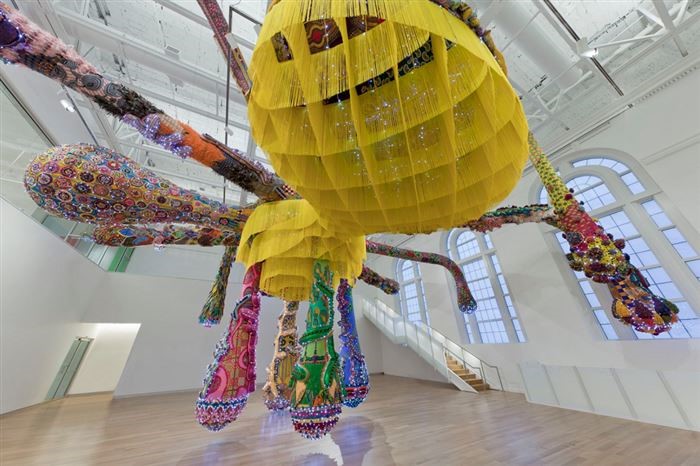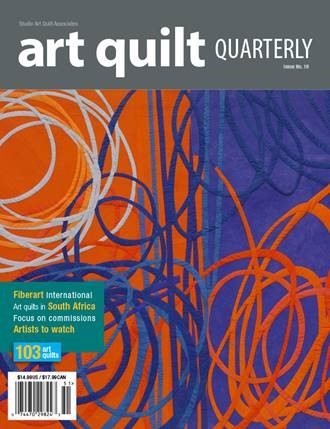Dear ALL
DATES TO DIARIZE:
- July. Fynarts Hermanus FynArts Select Exhibition Brochure: Art of Thread, curated by Dal Botha. See some of our artists works in the brochure: https://www.hermanusfynarts.co.za/wp-content/uploads/2020/06/Online-Shop-Thread-Art.pdf
- 13 September - 8 November 2020: Fibreworks XI Exhibition; Fibreworks Members' Exhibition at the Tatham Art Gallery in Pietermaritzburg. We still need confirmation from the Gallery. Everything is still highly fluid, given the pandemic. Should the exhibition be cancelled, we have decided to scrap the 2020 Members' show altogether and have our exhibition next year - 2024 - at the usual time, which is usually in October. We will keep everyone posted regarding any developments. More on this later.
- 25 - 26 September Nieu Bethesda Show, organized by Antoinette Kriel
See information below. - Virtual Exhibition of Fibreworks works at the Mexican Studies Centre at Wits University. More on this later. Contact Jenny Hearn for details
Exhibitions:
- FIBREWORKS XI Exhibition 2020 - MicroMacro
It was agreed that the following works/categories would be included in the exhibition whenever it finally materializes:
- Collaborative work : i.e. Member works with Roy Starke's work
- Member's own work
- Major Minors in 2 formats: A4 and square 25 x 25 cm
- Some of Roy's work that belongs to Fibreworks will be exhibited, depending on space at the venue.
- Exhibition with Mexican Studies Centre at Wits University
I am curating an exhibition at UJ with Dr David Ruiz from the University of Mexico, plus the Fashion Department and Jewellery Departments of UJ, and embroideries from Mexico which are on loan at present. I was approached by David to have an actual exhibition in September, but since lockdown, plans have been put on hold. It has now been decided that we'll have the virtual show. Obviously this will now become open to a wider audience.
Please send me pictures of OLD works that you have on hand, as many as you would like to share, plus the rationale.
I have shown the members of our group the Major Minors and the Innovative Threads booklets and they were most impressed by the quality of the work.
- Nieu Bethesda Show - Antoinette Kriel sent out this email:
It will be an intimate affair in my Studio, with the necessary precautions, no doubt - limited amount of people at a time, masks, hand sanitizer etc.
I'm just thankful that the local Karoo people will get a chance to appreciate your artwork!
I will post photos on my facebook page (Sewing at the C) if you'd like to have a look
Thank you again for participating, and hopefully we can do so again next year! "(Already sourced a bigger and more suitable venue…watch this space!)"
Members news:
Celia de Villiers sent this article and picture. If you want to see more images google Cassie Sim, the reporter and MutualArt the magazine.
- Weaving Stories: The Narrative Power of Contemporary Fiber Art
March 24, 2020
Fiber artists show how the elaborate qualities of this medium can form all sorts of connections and open up important discussions in thoughtful and productive ways.

The artist: Joana Vasconcelos. Valkyrie Mumbet. Photo by Will Howcroft. Courtesy MassArt
It wasn't until the '60s that fiber works took on more sculptural forms and were thus considered fine art rather than craft, as it was previously dismissed worse yet, a woman's craft.
By the '80s, artistic practices became increasingly conceptual, with fiber artists tackling issues such as gender, politics and the environment sometimes in conjunction with each other.
From a technical perspective, the fundamental qualities of fiber art seem to be constructiveness and connectivity, well-suited for the complicated issues frequently discussed in and beyond the art world; matching the complexity of these topics is the intricacy of fiber materials and its multitudes of binding methods, holding the pieces together.
This is an excellent article. Thank you Celia for sharing.
- Jeanette Gilks
Here is the article, featuring in Art Quilt Quarterly: ISSUE NO 18. "Art Quilts in South Africa" is on the cover.

Fibreworks: Art Quilts in South Africa
By Jeanette Gilks
Fibreworks members are humorously described today as "Ex-centrics" by member Celia de Villiers as our South African art group, founded in 1998, has moved from the traditional tenets of most quilt groups to the outer edges. Here some of the members talk about their love affair with textiles.
Rosalie Dace: "Sometimes my pieces are made by machine, and sometimes by hand, but generally both. They might be functional quilts or garments, or most times abstract explorations of color, line, and texture." These simple sentences cover the entire history of textiles from its ancient hand-crafted and functional past to the contemporary idea that textile art can be a manipulation of the elements of design using cloth as a medium. Rosalie continues, "Textiles fascinate me. The tactile quality and human history of cloth allow me to be part of an age-old tradition of folding, stitching, and feeling cloth."
Abstract surface design is also typical of Odette Tolkdorf's work: "Several ideas converge in one work and I inhale influences from many sources. I usually work by using a direct, improvisational approach." This intuitive, holistic way of working characterizes the way Jenny Hearn works, too. It's an "all-at-once" way of seeing, when the artwork itself is the guide, with the artist merely following. Jenny says, "I never know where a piece of work in going till I get there, and manipulating the fabric is demanding and difficult. I'm not always in control. But when the work becomes whole, that is the magic and the peace."
Many artists re-work textiles that have previously been used for other purposes. Pentimento contains material from an Australian vintage woollen blanket, and mulberry bark cloth from Tonga. The original "life "of the found material continues to live, or relive, in the new artwork. The wool remembers the old sheep and the bark-cloth remembers its tree. There seems to be a yearning of all things to be in some kind of relationship with other things. Pentimento, an art-historical term that refers to the presence of earlier marks made by an artist during the drawing or painting process, illustrates a desire to resurrect relationships between painting and stitching.
Kathy Harmer Fox also represents crossovers between painting and embroidery: "My art quilts are informed by my ability to draw and my paintings have been enlivened by my ability to stitch. One genre feeds the other, increasing the visual value of each." She begins by layering cut pieces of dress material, pinning each snippet of fabric to the canvas base, explaining "Some are faded with wear while others are garish, but once they are stitched, they become an eye or a tattoo."
"I am not what I am, I am what I do with my hands." Annette McMaster quotes Louise Bourgeois in that we become who we are through the actions of our hands. And the fact that our work "is never perfect, but a stimulus for the next creation, be it through drawing, painting, or collage," as Annette remarks, suggests that becoming who we are a lifelong, practical journey.
Sally Scott uses fabric to tell stories. Raised in the bushveld of Zimbabwe and Botswana, her works are a form of visual journaling. They become, as she says, "a kind of incomplete autobiography, weaving my life experiences, my passion for Africa, its people and its landscape." Although The Nurturer is a symbolic skirt displayed on a wall, the history and function of cloth as means of body covering is layered into the content of the work. Other skirts in this series of work represent aspects of the natural life cycle, and that human beings are an integral part of nature. She continues, "l love the feel of fabric, soaked in its saturated colour, rich in its various textures and characteristics. It is seductive and expressive." This in-the-flesh relationship quilt artists have with their work is transferred to the viewer. They want to "feel" the work, and they often ignore the various Hands Off signs at exhibitions, peering behind an art quilt or furtively bringing the corner of it to their cheek! Textile art illicits a powerful sense of touch.
For Celia de Villiers, the conceptual underpinning of the work is essential. "The art quilt should be more than merely pleasurable, beautiful, or decorative." This artist makes deliberate use of repurposed, post-consumer materials to comment critically on the environmental and biological effects of sea pollution: "How can technical manipulation of the medium reflect and transmit the contemporary creative involvement of the artist? Medium and concept are inseparable in my artworks. As my thinking and creative processes are essentially sculptural, I attempt to bend, and go beyond, the rules of traditional quilting and use textiles in a three-dimensional manner."
"The textile arts such as quilting and embroidery have played a big role in the social issues of race, gender, class, and politics", comments Phumzile Dhamini. She grew up in rural areas where grass weaving is practiced. "I learnt to recycle materials from my mother and am influenced by African beadwork…."Always promoting healing and cohesion amongst women, her work weaves together threads of post-colonialism and multiculturalism, demonstrating their interconnections, through which tradition can be both upheld and transformed.
The artworks here are transparent: We can look at them, and then with further looking, we look through them. They comment on the ongoing discussions concerning "woman's work" and the evolving nature of these ancient craft practices in contemporary quilt art.
http://fibreworksart.com
- Tessa Horan:
https://www.youtube.com/watch?v=RsKhi0x4Ni4
https://www.youtube.com/watch?v=zGEDHMF4rLI
Take care everyone. Keep well and keep working!
Jeanette and The Team
